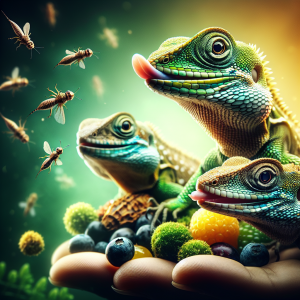Importance of Enrichment for Pet Lizards
Have you ever wondered why enrichment is so crucial for our scaly friends, the lizards? Picture this – imagine living in a room with nothing to do, no changes, no challenges. How boring would that be, right? Well, our pet lizards feel the same way! They need mental and physical stimulation to thrive in captivity.
Enrichment for lizards isn’t just about keeping them entertained; it’s about mimicking their natural habitat and behaviors in a captive setting. Think about it – in the wild, lizards have to hunt for food, explore their surroundings, and interact with other creatures. By providing enrichment challenges, we can recreate some of these experiences and keep our reptilian pals healthy and happy.
When I first started learning about lizard enrichment, I was amazed by how simple yet effective some of the strategies are. Did you know that something as basic as rearranging the items in your lizard’s enclosure can spark their curiosity and encourage natural behaviors? It’s like giving them a mini adventure every time you switch things up!
By offering a variety of enrichment activities, from puzzle feeders to climbing structures, we can engage our lizards’ minds and bodies in a meaningful way. Plus, it’s incredibly rewarding to see them explore, forage, and interact with their environment as they would in the wild.
So, the next time you interact with your pet lizard, think about how you can enrich their lives with engaging challenges. It’s not just about keeping them entertained; it’s about fostering their well-being and allowing them to express their natural behaviors. Stay tuned as we delve deeper into the types of enrichment challenges that can make a world of difference for our scaly companions.
Understanding Lizard Behavior and Needs
Understanding lizard behavior and needs is crucial when it comes to providing proper enrichment for our scaly friends. Did you know that lizards have unique personalities and preferences, just like us? It’s fascinating to observe how they interact with their environment and respond to different stimuli.
Imagine this – you’re setting up an enrichment challenge for your pet lizard, and you notice how they eagerly explore new objects or bask in a particular spot. This behavior reflects their natural instincts and requirements for mental and physical stimulation. By understanding these behaviors, we can tailor enrichment activities to suit our lizards’ individual needs and keep them engaged and happy.
Lizards are not just simple reptiles – they are intelligent creatures with distinct behaviors and requirements. For example, did you know that some lizard species are more arboreal, preferring to climb and explore vertical spaces, while others are ground-dwellers that enjoy burrowing and digging? Understanding these behavioral patterns can help us create enriching environments that cater to their specific needs.
When we delve deeper into lizard behavior and needs, we begin to appreciate the complexity of their cognitive abilities and sensory experiences. By observing how they interact with their surroundings, we can gain valuable insights into what enriches their lives and promotes their well-being. So, the next time you spend time with your pet lizard, take a moment to observe their behaviors and preferences – you might discover new ways to enhance their environment and provide enriching experiences tailored just for them.
Types of Enrichment Challenges for Lizards
Have you ever considered the different types of enrichment challenges that could benefit your pet lizard? It’s fascinating how these activities can enhance their well-being and keep them mentally stimulated. Let me share some insights on this topic.
When it comes to enrichment challenges for lizards, there are various options to explore. From sensory activities like providing different textures for them to explore to cognitive challenges such as food puzzles, the possibilities are endless. These challenges not only prevent boredom but also mimic their natural behaviors in the wild.
One interesting fact about lizard enrichment is that certain species exhibit unique preferences and behaviors. For example, some lizards may enjoy climbing challenges, while others may prefer hunting for their food. Understanding your lizard’s species-specific needs can help you tailor the enrichment activities to suit them best.
Incorporating enrichment challenges into your lizard’s daily routine can be both fun and rewarding. Imagine setting up a mini obstacle course for your lizard to navigate or creating a foraging activity to stimulate their natural hunting instincts. These activities not only provide physical exercise but also mental stimulation, keeping your pet engaged and happy.
By introducing a variety of enrichment challenges, you can create a dynamic and engaging environment for your pet lizard. It’s a great way to strengthen your bond with your scaly friend while promoting their overall health and well-being. So, why not get creative and start planning some exciting enrichment activities for your lizard today?
DIY Enrichment Ideas for Lizard Owners
Incorporate an interesting fact or trivia about IV:
Did you know that lizards have excellent problem-solving skills and can thrive when presented with engaging enrichment challenges? It’s truly fascinating how these reptiles can benefit from interactive activities designed to stimulate their natural behaviors and instincts.
When it comes to DIY enrichment ideas for your pet lizard, the possibilities are endless! From creating obstacle courses using cardboard tubes and PVC pipes to setting up a foraging station with hidden treats, there are many ways to keep your scaly friend entertained and mentally engaged.
One of the most rewarding aspects of providing enrichment for lizards is observing their curious nature and adaptive abilities in action. I remember setting up a simple climbing wall in my bearded dragon’s enclosure, unsure of how he would react. To my surprise, he eagerly explored the new addition, showcasing his agility and problem-solving skills as he navigated the various obstacles.
Whether you have a bearded dragon, leopard gecko, or another lizard species, incorporating DIY enrichment activities can enhance their overall well-being and quality of life. Not only does it provide mental stimulation and physical exercise, but it also helps prevent boredom and reduce stress in captive reptiles.
So, why not get creative and design some fun challenges for your pet lizard today? By offering a variety of enrichment opportunities tailored to their species-specific needs, you can create a stimulating environment that promotes natural behaviors and encourages active engagement. Your lizard will thank you for the extra effort with increased activity levels, improved mood, and a happier, healthier life overall.
Incorporating Natural Elements into Lizard Enclosures
When it comes to creating a stimulating environment for pet lizards, incorporating natural elements into their enclosures can make a world of difference. Picture this: imagine walking through a lush tropical forest, hearing the rustle of leaves and feeling the warmth of the sun on your skin. Now, think about how you can recreate a slice of this natural paradise for your scaly friends right in your own home.
Adding natural elements such as rocks, branches, and live plants to your lizard’s enclosure not only enhances the aesthetics but also provides them with opportunities for exploration and enrichment. These elements mimic the lizard’s natural habitat, offering them the chance to climb, bask, and hide just like they would in the wild. Plus, live plants can help maintain humidity levels and improve air quality within the enclosure, benefiting both your lizards and your indoor environment.
Did you know that certain plant species can also serve as a food source for your lizards? Including edible plants like hibiscus, spider plants, or dandelions in their enclosure can offer them a nutritious snack while adding a pop of greenery to their space. Just make sure to research which plants are safe for your specific lizard species, as some plants may be toxic if ingested.
When setting up a naturalistic enclosure for your lizards, consider the size and layout of the enclosure to provide ample space for the plants to thrive and for your lizards to move around comfortably. Create different levels and hiding spots using branches and rocks to encourage natural behaviors like climbing and basking. Remember to regularly monitor the plants for signs of stress or damage, and make adjustments as needed to ensure your lizards’ safety and well-being.
By incorporating natural elements into your lizard’s environment, you are not only creating a visually appealing setup but also promoting their physical and mental health. So, why not bring a piece of the great outdoors into your home and watch your lizards thrive in their own little slice of paradise?
Monitoring and Adapting Enrichment Activities
Have you ever noticed how your pet lizard reacts to different enrichment activities? It’s fascinating to see how they interact with their environment, isn’t it? When it comes to monitoring and adapting enrichment activities for your lizard, it’s all about observing their behavior and making adjustments as needed.
Let me share a personal anecdote with you. I once introduced a new climbing structure in my lizard’s enclosure, thinking it would provide a fun challenge for him. However, I quickly realized that he was hesitant to use it and seemed more comfortable exploring ground-based activities. By paying attention to his preferences and behavior, I was able to modify the enrichment setup to better suit his needs and interests.
Observation is key when it comes to monitoring your lizard’s response to enrichment challenges. Take note of how they interact with different elements in their environment. Are they showing curiosity, excitement, or hesitation? By being attentive to these cues, you can tailor the activities to cater to your lizard’s preferences and ensure they are benefiting from the enrichment provided.
Adapting enrichment activities for your lizard may involve tweaking the setup, introducing new elements, or removing ones that don’t seem to engage them. It’s a process of trial and error, but ultimately, your goal is to create a stimulating and rewarding environment for your pet. Remember, every lizard is unique, so what works for one may not work for another.
As you continue to monitor and adapt enrichment challenges for your lizard, you’ll develop a deeper understanding of their behavior and preferences. This hands-on approach not only benefits your pet’s well-being but also strengthens the bond between you. So, keep observing, experimenting, and most importantly, have fun enriching your lizard’s life!
Benefits of Enrichment Challenges for Lizards
When it comes to the benefits of enrichment challenges for lizards, it’s like giving them a taste of the wild right in their own home. Just imagine the joy and excitement your pet lizard experiences when they have to solve a puzzle to reach their meal or navigate through an obstacle course you’ve set up for them.
These enrichment activities aren’t just for our entertainment – they play a crucial role in keeping our scaly friends mentally stimulated and physically active. It’s fascinating to see how lizards, with their unique behaviors and instincts, engage with these challenges. Did you know that providing enrichment opportunities can help reduce stress and boredom in captive lizards, leading to healthier and happier pets? It’s like hitting the jackpot for lizard well-being!
Now, I know you might be wondering, “But what are the actual benefits of these enrichment challenges?” Well, let me tell you, my friend. Not only do these activities keep your lizard entertained and engaged, but they also encourage natural behaviors, promote problem-solving skills, and enhance their overall quality of life. It’s like giving them a mini adventure every day, right in their terrarium.
Imagine setting up a mini treasure hunt for your lizard, watching them explore and interact with their environment in ways that mimic their instincts in the wild. It’s both rewarding for you as the pet owner and enriching for your scaly companion. So, next time you’re thinking about how to spice up your lizard’s routine, consider incorporating some fun and challenging enrichment activities. Trust me, your lizard will thank you in their own unique way!
Addressing Common Challenges in Lizard Enrichment
When it comes to addressing common challenges in lizard enrichment, one practical tip that I’ve found really helpful is to observe your lizard’s behavior closely. It may sound simple, but understanding how your lizard interacts with different enrichment activities can provide valuable insights into what works best for them.
For example, I once set up a DIY climbing structure in my lizard’s enclosure, thinking it would be a hit. However, after observing my lizard’s behavior, I noticed that they were hesitant to use it and seemed more interested in exploring different textures on the ground. This observation led me to adjust the enrichment activities to better suit my lizard’s preferences, ultimately enhancing their overall enrichment experience.
By paying attention to your lizard’s behavior and being willing to adapt, you can address challenges and ensure that the enrichment activities you provide are not only stimulating but also enjoyable for your scaly friend. Remember, every lizard is unique, so what works for one may not work for another. Being flexible and open to trying new ideas can lead to a more enriching environment for your pet.
So, the next time you’re setting up enrichment challenges for your lizard, take some time to observe how they interact with different stimuli. You might be surprised by what you learn and how it can help you overcome common challenges in lizard enrichment. Your lizard will thank you for it with their happy and active demeanor!
Enrichment Safety Tips for Pet Lizards
Have you ever considered the safety of enrichment activities for your pet lizard? It’s essential to prioritize their well-being while providing stimulating experiences. I remember when I first started incorporating enrichment challenges for my lizard, Spike. I was so excited to see him engage with new toys and obstacles in his enclosure. However, I quickly realized the importance of ensuring that these activities were safe and beneficial for him.
One practical tip that I learned along the way is to carefully monitor your lizard during enrichment sessions. By observing their behavior closely, you can assess their comfort level and adjust the activities accordingly. It’s crucial to create a balance between challenges that encourage natural behaviors and activities that may cause stress or harm.
Ensuring enrichment safety for pet lizards goes beyond just choosing the right activities. You also need to consider the materials and equipment you use. Avoid any items that could be ingested or pose a choking hazard. Opt for natural, non-toxic materials and toys specifically designed for reptiles.
Another aspect to keep in mind is the temperature and lighting conditions in your lizard’s habitat. Some enrichment activities may require adjustments to the lighting or heating sources to ensure your lizard stays healthy and comfortable throughout the experience.
By prioritizing safety in your lizard’s enrichment routine, you can create a stimulating environment that promotes their physical and mental well-being. Ultimately, the goal is to provide enriching experiences that enhance their quality of life and keep them happy and healthy for years to come. Remember, a safe and engaging environment is key to a thriving pet lizard!
Creating a Stimulating Environment for Happy, Healthy Lizards
Enrichment challenges for pet lizards are not only fun but also essential for their well-being. Imagine creating a mini jungle gym for your scaly friend – it’s like a playground in their own habitat!
When I first started exploring enrichment ideas for my pet lizard, I was amazed at how engaging and interactive these activities could be. It’s fascinating to see how they react to new stimuli and challenges. Did you know that lizards are intelligent creatures that thrive on mental stimulation? Incorporating enrichment activities can help prevent boredom and encourage natural behaviors in captivity.
One practical tip I learned along the way is to observe your lizard’s behavior closely to understand their preferences. Some lizards may enjoy climbing, while others prefer digging or foraging. By tailoring the enrichment challenges to suit your lizard’s interests, you can ensure they stay engaged and entertained.
Have you ever considered the broader implications of providing enrichment for pet lizards? Not only does it enhance their physical and mental health, but it also strengthens the bond between you and your pet. Creating a stimulating environment can lead to a happier and healthier lizard overall.
Exploring different enrichment challenges can be a rewarding experience for both you and your lizard. From setting up obstacle courses to introducing new textures and scents, the possibilities are endless. Just remember to prioritize safety and monitor your lizard’s response to ensure they are enjoying the activities.
So, why not get creative and start incorporating enrichment challenges into your lizard’s daily routine? It’s a fantastic way to enrich their lives and bring a sense of excitement to their environment. Your scaly companion will thank you for it with their curious and active behavior!




